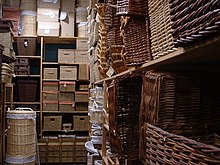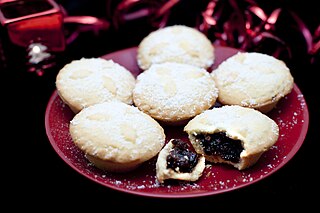
A mince pie is a sweet pie of English origin filled with mincemeat, being a mixture of fruit, spices and suet. The pies are traditionally served during the Christmas season in much of the English-speaking world. Its ingredients are traceable to the 13th century, when returning European crusaders brought with them Middle Eastern recipes containing meats, fruits, and spices; these contained the Christian symbolism of representing the gifts delivered to Jesus by the Biblical Magi. Mince pies, at Christmas time, were traditionally shaped in an oblong shape, to resemble a manger and were often topped with a depiction of the Christ Child.

A picnic is a meal taken outdoors as part of an excursion, especially in scenic surroundings, such as a park, lakeside, or other place affording an interesting view, or else in conjunction with a public event such as preceding an open-air theater performance, and usually in summer or spring. It is different from other meals because it requires free time to leave home.

Christmas pudding is sweet, dried-fruit pudding traditionally served as part of Christmas dinner in Britain and other countries to which the tradition has been exported. It has its origins in medieval England, with early recipes making use of dried fruit, suet, breadcrumbs, flour, eggs and spice, along with liquid such as milk or fortified wine. Later, recipes became more elaborate. In 1845, cookery writer Eliza Acton wrote the first recipe for a dish actually called "Christmas pudding".

Marzipan is a confection consisting primarily of sugar and almond meal, sometimes augmented with almond oil or extract.

Fruitcake or fruit cake is a cake made with candied or dried fruit, nuts, and spices, and optionally soaked in spirits. In the United Kingdom, certain rich versions may be iced and decorated.

Stollen is a fruit bread of nuts, spices, and dried or candied fruit, coated with powdered sugar or icing sugar and often containing marzipan. It is a traditional German Christmas bread. During the Christmas season the cake-like loaves are called Weihnachtsstollen or Christstollen.
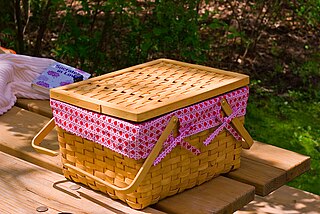
A picnic basket or picnic hamper is a basket intended to hold food and tableware for a picnic meal. Picnic baskets are standard equipment at many picnics. A traditional picnic hamper is made of woven wicker.

Christmas cake is a type of cake, often fruitcake, served at Christmas time in many countries.
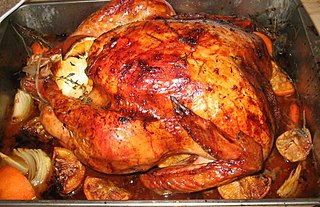
Christmas dinner is a meal traditionally eaten at Christmas. This meal can take place any time from the evening of Christmas Eve to the evening of Christmas Day itself. The meals are often particularly rich and substantial, in the tradition of the Christian feast day celebration, and form a significant part of gatherings held to celebrate the arrival of Christmastide. In many cases, there is a ritual element to the meal related to the religious celebration, such as the saying of grace.

A gift basket or fruit basket is typically a gift delivered to the recipient at their home or workplace. A variety of gift baskets exist: some contain fruit; while others might contain dry or canned foods such as tea, crackers and jam; or the basket might include a combination of fruit and dried good items. Gourmet gift baskets typically include exotic fruit, and often include quality cheese and wine, as well as other nonfood items. Gift baskets are often sent for special occasions—such as holidays—or as a thank-you or congratulations gift. In certain occasions, it is given as a sympathy gift or a condolence gift during funerals. In some countries in Asia, people use fruit basket as a decoration. They either eat it after the funeral service where the casket is laid in the cemetery or they leave the fruit baskets at their graves to let the dead rest in peace.
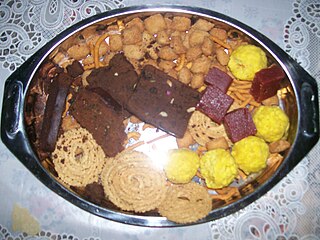
Kuswar or Kuswad is a set of festive sweets and snacks made and exchanged by Christians of the Konkan region in the Indian subcontinent for the Christmas season or Christmastide. These goodies are major parts of the cuisines of the Goan Catholic community of Goa in the Konkan region, and the Mangalorean Catholic community of Karnataka. There are as many as 22 different ethnic recipes that form this distinct flavour of Christmas celebration in Goa and Mangalore. Kuswad is also made and exchanged by Karwari Catholics of Carnataca and the Kudali Catholics of Sindhudurg, in the Konkan division of Maharashtra.

Fijian cuisine has long consisted of primarily foraged and farm-grown food. Although rice, wheat, and tea all became staples during Fiji's colonial era, native Fijians still eat primarily tubers and coconuts. The cuisine of Fiji is known for its seafood and various green vegetables, including ''ota'', a young forest fern, and ''bele'', a plant that resembles spinach.

A rum cake or black cake is a type of dessert cake which contains rum. In most of the Caribbean, rum cakes are a traditional holiday season dessert, descended from the holiday puddings. Traditionally, dried fruit is soaked in rum for months and then added to dough prepared with sugar which has been caramelized by boiling in water. The result, also known as "black cake", is similar to a fruitcake, with a lighter texture.

Ripley Hampers founder Quintin Acomb first set up the British hamper company in 1834. The Ripley brand also applies to other enterprises undertaken by the Ripley Group of companies, including Ripley Fine Foods Limited, Ripley Traditional Sweet Company, Ripley Ice Cream and Ripley Store.

Christmas traditions in Australia, like Christmas in New Zealand, have many similarities to British, Irish, American and Canadian traditions, including traditional Christmas symbols featuring winter iconography. This means a red fur-coated Father Christmas or Santa Claus riding a sleigh, songs such as "Jingle Bells", and various Christmas scenes on Christmas cards and decorations. However, the timing of Christmas occurring during the Southern Hemisphere's summer season has resulted in the development of some local traditions as a result of the warmer weather.
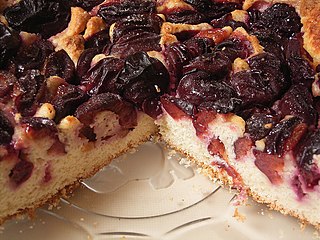
Plum cake refers to a wide range of cakes usually made with dried fruits such as currants, raisins, sultanas, or prunes, and also sometimes with fresh fruits. There is a wide range of popular plum cakes and puddings. Since the meaning of the word "plum" has changed over time, many items referred to as plum cakes and popular in England since at least the eighteenth century have now become known as fruitcake. The English variety of plum cake also exists on the European mainland, but may vary in ingredients and consistency. British colonists and missionaries brought the dried fruit variety of cake with them, for example, in British India where it was served around the time of the Christmas holiday season. In America's Thirteen Colonies, where it became associated with elections, one version came to be called election cake.
